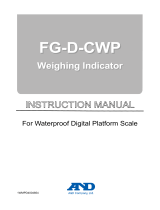
2 KIB-TM-BA_IA-e-1912
GB
Version 1.2 2019-01
Operating and installation instructions
Contents
1 Technical data ................................................................................................ 4
2 Appliance overview ....................................................................................... 5
2.1 Keyboard overview ..................................................................................................................... 6
2.1.1 Numeric entry via navigation keys .............................................................................................. 7
2.2 Overview of display .................................................................................................................... 8
3 Basic Information (General) .......................................................................... 9
3.1 Proper use .................................................................................................................................. 9
3.2 Improper Use .............................................................................................................................. 9
3.3 Warranty ..................................................................................................................................... 9
3.4 Monitoring of Test Resources .................................................................................................. 10
4 Basic Safety Precautions ............................................................................ 10
4.1 Pay attention to the instructions in the Operation Manual........................................................ 10
4.2 Personnel training ..................................................................................................................... 10
5 Transport and storage ................................................................................. 10
5.1 Testing upon acceptance ......................................................................................................... 10
5.2 Packaging / return transport ..................................................................................................... 10
6 Unpacking and installation ......................................................................... 11
6.1 Installation Site, Location of Use .............................................................................................. 11
6.2 Unpacking ................................................................................................................................. 11
6.3 Scope of delivery / serial accessories: ..................................................................................... 11
6.4 Transportation lock (illustration example) ................................................................................. 12
6.5 Error message .......................................................................................................................... 12
6.6 Placing ...................................................................................................................................... 12
6.7 Mains connection ...................................................................................................................... 14
6.8 Storage battery operation (optional) ......................................................................................... 14
6.9 Adjustment ................................................................................................................................ 15
6.10 Linearization ............................................................................................................................. 17
7 Operation ...................................................................................................... 19
7.1 Start-up ..................................................................................................................................... 19
7.2 Switching Off ............................................................................................................................ 19
7.3 Zeroing ..................................................................................................................................... 19
7.4 Simple weighing ....................................................................................................................... 19
7.5 Switch-over weighing unit ......................................................................................................... 20
7.6 Weighing with tare .................................................................................................................... 21
7.6.1 Pre-Tare ................................................................................................................................... 21
7.7 Weighing with tolerance range ................................................................................................. 22
7.7.1 Tolerance check for target weight ............................................................................................ 23






















